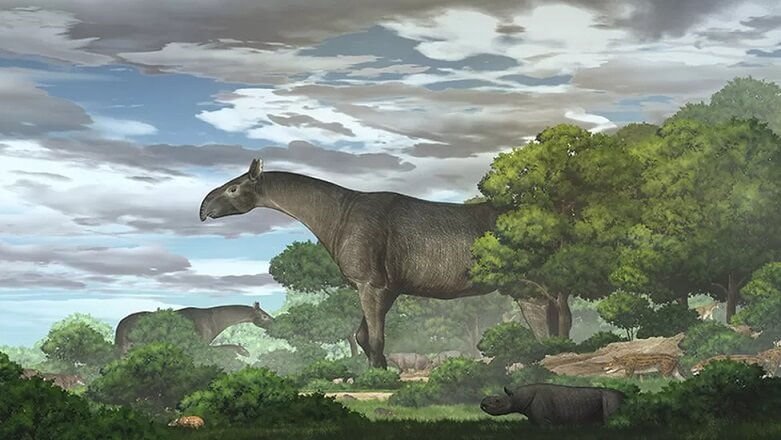
This Prehistoric Giant Rhino Was ‘Taller Than A Giraffe’
The prehistoric mammal had a 3.8-foot-long head and stood at about 16 feet tall
By: Elizabeth Gamillo | Smithsonian
The giant rhinoceros roamed Eurasia sometime between 20 million and 35 million years ago. The extinct behemoth stretched over 26 feet long and weighed almost as much as five elephants. Now, palaeontologists have unearthed partial remains of a new species of giant rhino in China, according to a study published last week in the journal Communications Biology.
The newly discovered giant rhino (Paraceratherium linxiaense) is the sixth species of hornless rhino found in Asia. The remains may help palaeontologists explain the origins of the ancient rhinos, their range across Eurasia, and how they evolved, reports Carly Cassella for Science Alert.
Giant rhinos are thought to be the largest land mammals to ever live. Their fossils have been found all across Asia, including China, Mongolia, Kazakhstan, and Pakistan, reports George Dvorsky for Gizmodo. However, their dispersal throughout Asia is not fully understood.
Two individual giant rhinos were unearthed in 2015 from Late Oligocene deposits that date to 26.5 million years ago in the Linxia Basin in China, an area known for its abundance in fossils. The fossils included a skull, mandible, and several spinal vertebrae, reports Gizmodo. Tao Deng, a palaeontologist at the Chinese Academy of Sciences, and his team used laser scans to create 3-D reconstructions of the ancient beasts from the remains.
T. Rex Didn’t Kiss & Tell, But May Have Had Lips
The prehistoric beast stood nearly 16 feet tall on four bony legs similar to giraffes and weighed between 11 to 20 metric tons, which is equivalent to about three to five African elephants, Science Alert reports. Based on the size of the skull, the rhino had a long thick neck, a deeper nasal cavity, and a short trunk similar to that of a modern-day tapir, reports the BBC. The vertebrae fossils suggest the new species had a more flexible neck than other species of giant rhinoceroses, the researchers explain in a statement.
Deng suggests that the rhino’s thin legs were great for running, and its head could reach the highest leaves from the treetops, Gizmodo reports. After further analysis, the scientists also found the new species was closely related to a giant rhino that lived in Pakistan, Paraceratherium bugtiense, suggesting that it migrated across Central Asia at one point, per the BBC.
During the Early Oligocene, the climate around Central Asia was arid, while South Asia was more humid and filled with a patchwork of open landscape and green forests, reports Tom Metcalfe for NBC News. The giant rhinos likely migrated to South Asia in search of food to fill their bellies. Then, during the late Oligocene, the rhinos ventured back northward when the climate changed again and Central Asia was no longer arid.
The trail of various giant rhino fossils suggest they migrated from the Mongolian Plateau into northwest China and Kazakhstan and then down through Tibet into Pakistan, Science Alert reports. Overall, this route implies that the Tibetan region was not the high-elevation, plateau riddled with mountains it is today. Instead, it likely had some lowlands the mammals could pass through millions of years ago.
“Animal migration is linked to climate change. So 31 million years ago, when the Mongolian plateau dried up, they moved south,” Deng said to CNN’s Jack Guy and Zixu Wang.
The fossils currently reside in the Hezheng Paleozoological Museum in the north-central Gansu province in China. In future studies, Deng and his team hope to reconstruct the rhino’s muscles to get a more accurate estimate of the mammal’s body mass.
* * *
NEXT UP!
10 Fascinating Facts About Quetzalcoatlus: The Cretaceous Sky Giant
Pterosaurs, the first vertebrates to evolve powered flight, ruled the Mesozoic skies long before birds took to the air. They ranged from the size of sparrows to giants like quetzalcoatlus, which stood as tall as a giraffe when on the ground. Yet, despite their impressive history and diversity, significantly less attention has been devoted to understanding their extinction.
Recent discoveries have expanded our understanding of pterosaur diversity at the end of the Cretaceous. Palaeontologists initially believed that only the giant azhdarchids, like quetzalcoatlus, were present during this era. However, recent findings have identified rare members of other pterosaur groups in rocks of the same age, indicating that pterosaurs were perhaps more diverse at the end of the Cretaceous than previously appreciated.
Intriguingly, many of these pterosaurs were found in oceanic environments, contrary to the previous belief that most Late Cretaceous pterosaurs lived inland. This suggests that pterosaurs were thriving in diverse habitats rather than dwindling when the extinction event occurred.
* * *
READ MORE: A Dinosaur Killed On The Day of The Fatal Asteroid May Have Been Discovered
Read more on Amazing Dinosaur Facts: Giant ‘Death Shadow’ Dinosaur Found In Argentina Is Largest Megaraptor On Record
Liked it? Take a second to support Collective Spark.
We’d love to hear from you! If you have a comment about this article or if you have a tip for a future Collective Spark Story please let us know below in the comment section.
